Cut Out Animation Rages Through The Ages
 Parts of a Frog - Flash Animation Cut Outs
Parts of a Frog - Flash Animation Cut OutsCut out animation is considered the oldest animation technique around – probably the first in animation history.
Traditional cut-outs belong to the stop motion animation family. It is one of the easiest and fastest to make, because you don’t have to draw and color each frame from scratch.
This animation technique has many variations and forms.
In the traditional technique, the animator moves pieces of paper cutouts under a fixed camera. You shoot it “straight ahead”, frame by frame as they come. The arrival of the computer took cut-outs to a whole new level of madness and creativity. Computer cut-outs have the immense advantage of being able to go back and forth on the timeline and work with key frames, in the “pose to pose” method.
Not everyone wants to, though, as we will see.
There are several Flash Cut Out Animation Tutorials on this site, browse the Learn Flash section of this site to get started.
Cut Out Animation History
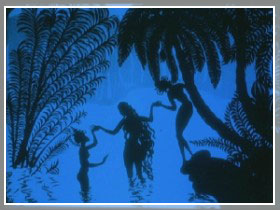 The Adventures of Prince Achmed
The Adventures of Prince AchmedThe first animator to make cutout animation – as far as anyone knows – was Lotte Reiniger, with “The Adventures of Prince Achmed”, in Germany, 1926.
She used elaborate paper silhouettes to tell a full, feature-length, magical story. Animation historian William Moritz sets the record straight for her in this article for Animation World Magazine.
Silhouettes allow great freedom for an animator.
You can “hide” in the overlapping sections, and create the illusion of three dimensional figures moving in space, as you can see in this example:
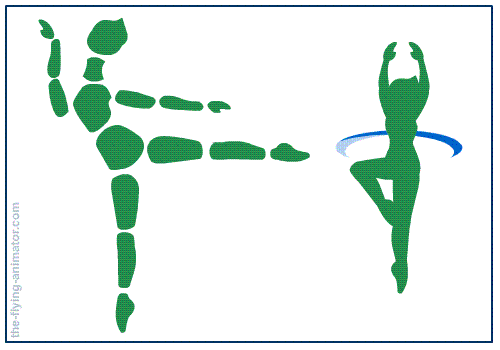
You can take the pieces and draw a face on them, but that slams you back, and hard, to the 2D world, and it’s not just “2D”, like classic animation. When you draw details on the cut outs, your animation is limited to the angle you drew each character in.
This is when it gets rough and fast and dirty - and fun!
Rough and Tough Animators
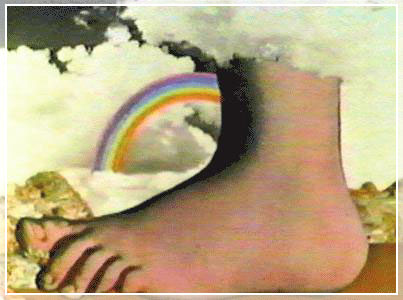 Monty Python's Flying Circus
Monty Python's Flying CircusAnimator Terry Gilliam used the roughness of the cutout technique to complement the In-Your-Face humor of Monty Python’s Flying Circus.
He used parts of photographs and a lot of ready-made graphic material to work fast and funny. In the 1970’s this was all still hand made animation.
A couple of decades later two guys shut themselves in a basement in Colorado and made an outrageous animated Christmas card, that would soon after evolve into a TV series.
Matt Stone and Trey Parker made the pilot episode for South Park in the good old fashioned way, all 22 minutes of it. This took 70 days which Stone described as “hell on this earth”.
There had to be another way.
Another animator, Terrence Masson, suggested to go CG.
Computer animation in the mid 1990’s was just coming into its own, and this was not the natural choice it might seem to be today. More than that, Parker and Stone wanted the dirty hand made construction-paper look. They WANTED the rough and limited animation.
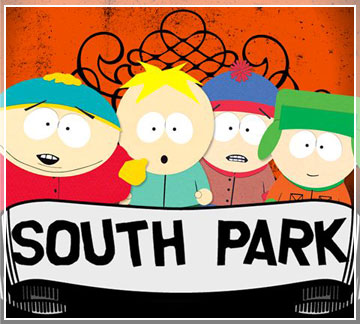 South Park cut outs- from cardboard to 3D
South Park cut outs- from cardboard to 3DEverything looks so smooth and pretty with a computer. SP people put a lot of effort to make it look hand made again.
Splines? Curves? 3D? Who needs them!
So what if the computer CAN do all of these things? If it’s not right for Kenny, don’t use it. Not just because "it’s there” - the worst reason to use a feature is just "cause it's there".
The computer allowed them to make an episode a week, that’s all they wanted.
They stuck with their own thing.
Extra Fine Art
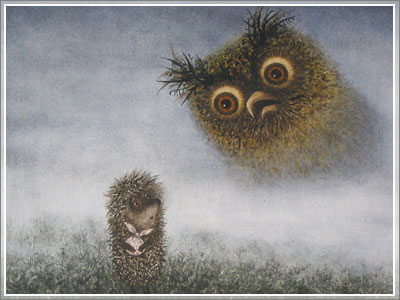 Hedgehog in the Fog
Hedgehog in the FogOn the opposite end of going all the way, we fine Yuri Norstien, and his “Overcoat”.
Cut out animation doesn't HAVE to be crass.
This famous Russian Animator is the very opposite of SP or Python.
His films are lyrical, highly artistic and very fine, very elaborate.
For some 20 years now, he and his wife have been working on “The Overcoat”, an adaptation of the story by Gogol.
Mrs. Norstein hand paints the many parts of each character on tiny celluloid pieces.
Mr. Norstein then painstakingly animates them under a camera, with a pair of tweezers.
There seems to be no deadline in sight.
(“I love deadlines. I love the whooshing noise they make as they go by” said Douglas Adams)
Crazy?
Crazier than Stone and Parker and Monty Python?
Mr. Norstein has made several movies in his long life, including one that is – in my opinion – the most beautiful cut-out animation ever made, “The Hedgehog in the Fog”.
I do hope “The Overcoat” will be finished in my lifetime.
I'm waiting.
Flash Cut Out Animation
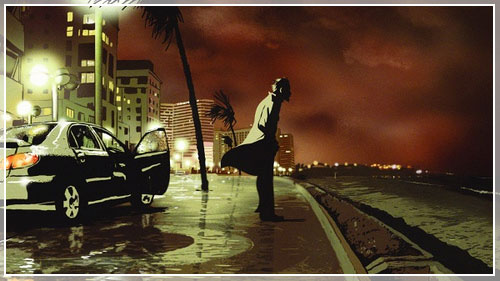 Waltz with Bashir - Flash cut out full length feature
Waltz with Bashir - Flash cut out full length featureCut out animation got a whole new life when Flash showed up.
This software, actually a web authoring tool, made cut out animation so easy to make that EVERYONE became an animator. For one dangerous moment it looked like someone has found the legendary “Make Animation” button.
This misuse of Flash gave it a bit of a bad name, and unjustly so.
The quality of the animation depends on the animator, really.
There is no “Make Animation” button. Sorry.
The truly wonderful thing about Flash and its friends was that it turned a single home-based animator into an animation studio. Flash today is used for everything between banner web animations to full feature films shown in the cinema. Many TV productions use it to cut budgets and work fast. (Rumors of it's death were premature.)
Ari Folman’s film “Waltz With Bashir” gave animation director Yoni Goodman a chance to see just how far you can go with Flash cutout animation.
It took them to the Oscar.
I love cut outs.
You might have guessed that, browsing this site ;-)
I love the fast pace of work that it allows, and I find a strange kind of pleasure in working out ways to do things INSIDE the built in limitations of this technique. Sometimes the limitation itself forces me to be more creative, and if that’s not good for an artist, I don’t know what is.
Related Articles:
Home > Types of animation > Cut-Out Animation
Articles
How Does computer Animation Work
Character Design - A Stroll with Famous Felines
Making Animation
Recording Voice Talents for Animation
How to Draw A Cat Tutorial - step by step!
